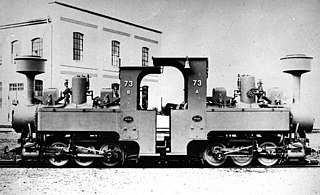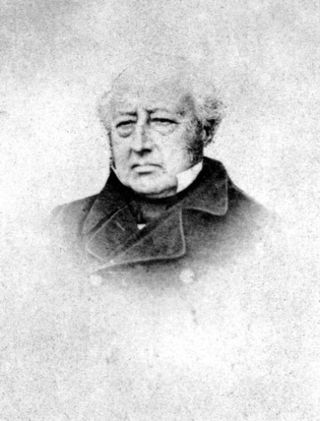
Stephenson's Rocket is an early steam locomotive of 0-2-2 wheel arrangement. It was built for and won the Rainhill Trials of the Liverpool and Manchester Railway (L&MR), held in October 1829 to show that improved locomotives would be more efficient than stationary steam engines.

A steam locomotive is a locomotive that provides the force to move itself and other vehicles by means of the expansion of steam. It is fuelled by burning combustible material to heat water in the locomotive's boiler to the point where it becomes gaseous and its volume increases 1,700 times. Functionally, it is a steam engine on wheels.

Under the Whyte notation for the classification of steam locomotives, 0-4-2 represents the wheel arrangement with no leading wheels, four powered and coupled driving wheels on two axles and two trailing wheels on one axle. While the first locomotives of this wheel arrangement were tender engines, the configuration was later often used for tank engines, which is noted by adding letter suffixes to the configuration, such as 0-4-2T for a conventional side-tank locomotive, 0-4-2ST for a saddle-tank locomotive, 0-4-2WT for a well-tank locomotive and 0-4-2RT for a rack-equipped tank locomotive.

The Liverpool and Manchester Railway (LMR) 57 Lion is an early 0-4-2 steam locomotive, which had a top speed of 40 mph (64 km/h) and could pull up to 200 tons. One of a pair designed for hauling freight, Lion was built by Todd, Kitson & Laird of Leeds in 1838. It featured in the 1953 Ealing comedy, The Titfield Thunderbolt.
Kitson and Company was a locomotive manufacturer based in Hunslet, Leeds, West Yorkshire, England.

Henry Booth was a British corn merchant, businessman and engineer particularly known as one of the key people behind the construction and management of the pioneering Liverpool and Manchester Railway (L&M), the world's first steam railway conducting both scheduled passenger services and freight.
Haigh Foundry was an ironworks and foundry in Haigh, Lancashire, which was notable for the manufacture of early steam locomotives.
R and W Hawthorn Ltd was a locomotive manufacturer in Newcastle upon Tyne, England, from 1817 until 1885.
B. Hick and Sons, subsequently Hick, Hargreaves & Co, was a British engineering company based at the Soho Ironworks in Bolton, England. Benjamin Hick, a partner in Rothwell, Hick and Rothwell, later Rothwell, Hick & Co., set up the company in partnership with two of his sons, John (1815–1894) and Benjamin Jr (1818–1845) in 1833.

The Bury Bar Frame locomotive was an early type of steam locomotive, developed at the Liverpool works of Edward Bury and Company, later named Bury, Curtis, and Kennedy in 1842. By the 1830s, the railway locomotive had evolved into three basic types - those developed by Robert Stephenson, Timothy Hackworth and Edward Bury.
George Forrester and Company was a British marine engine and locomotive manufacturer at Vauxhall Foundry in Liverpool, established by Scottish engineer George Forrester. The company opened in 1827 as iron founders and commenced building steam locomotives in 1834.

Doll is a 2 ft gauge 0-6-0T steam locomotive based at the Leighton Buzzard Narrow Gauge Railway in Bedfordshire.

The South West African Zwillinge 0-6-0T of 1898 was a narrow gauge steam locomotive from the German South West Africa era.

Edward Bury was an English locomotive manufacturer. Born in Salford, Lancashire, he was the son of a timber merchant and was educated at Chester.

Sir Haydn is a narrow gauge steam locomotive, built by Hughes's Locomotive & Tramway Engine Works, Loughborough in 1878. It operated on the Corris Railway in Wales, until closure in 1948, and since 1951 has operated on the nearby Talyllyn Railway. It has carried the operating number 3 under four successive owners.

The South West African Jung 0-6-2T of 1904 was a narrow gauge steam locomotive from the German South West Africa era.

Eastham Country Park is a country park located in Eastham, Wirral. The park is situated next to the River Mersey and covers an area of 100 acres (40 ha). Facilities at the park include a visitor information centre, tea garden and picnic areas. There are two jetties that were formerly used to ferry people and goods from Wirral to Liverpool with the road leading to the park called 'Ferry Road.'

The Minotaurus and Ajax were a pair of 0-4-2 steam locomotives purchased by the Kaiser Ferdinands-Nordbahn (KFNB) – Emperor Ferdinand Northern Railway from Jones, Turner and Evans of Newton-le-Willows, England in 1841; Minotaurus has been scrapped, Ajax survives and is believed to be the oldest preserved steam locomotive on the European mainland and is currently exhibited at the Technisches Museum Wien.

Swiftsure was first of eight or more similar locomotives with a single pair of driving wheels built by George Forrester and Company (Forresters) from 1834. The tank variant was the first passenger tank engine to enter service in the world.















